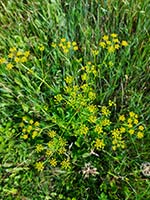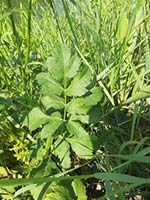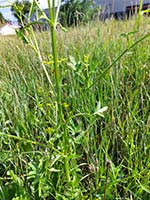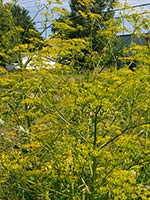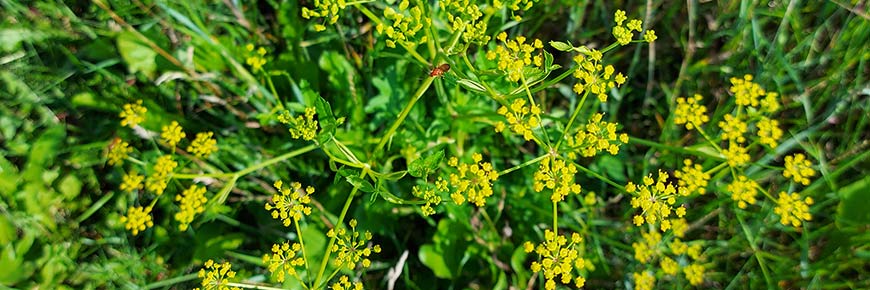
Pastinaca sativa
Wild Parsnip
Chambly Canal National Historic Site
Description
Wild parsnip is an invasive alien species of the umbelliferae family native to Europe and Asia, whose root is edible. It is very abundant along roadsides, bike paths, agricultural ditches and railways. It can also be found in open areas such as fallow fields, vacant lots, stream banks and hedgerows along the edges of fields. It is found in great density at the Chambly Canal National Historic Site!
How to recognize wild parsnip
| FLOWERING | May to October |
| FLOWERS | 10–20 cm umbels, yellow |
| FOLIAGE | Leaves in pairs, toothed outline, looks like celery |
| ROOT | Carrot-shaped, 50–100 cm deep |
| STEM | Green, hollow and fluted, 2–5 cm thick, some hairs |
| PLANT HEIGHT | From 40 to 200 cm |
| ALLERGENIC ELEMENT | Sap in the stems, leaves, flowers and roots |
| REACTION | Dermatitis, first-degree burns up to second-degree burns |
Spread
Pollinated by insects, a plant can produce an average of 300 to 1,000 seeds. These are spread mainly by wind, land vehicles and by floating on waterways.
Impacts
Wild parsnip can create dense stands, thereby harming biodiversity, native plants and forage plants. The sap of the wild parsnip contains toxins that are useful for protecting the plant from insects and herbivores. These molecules contained in the sap can cause severe skin irritation in humans when combined with sun exposure (photodermatitis). The reaction may occur as a result of direct contact with the flowers, leaves, roots or stems, or indirect contact with the sap (clothing, gardening tools). Irritation usually appears within 48 hours of exposure as a blister or burn, which may result in long-term scarring or persistent brown spots.
Prevention and protective measures
To avoid coming into contact with the plant's sap, several tips can be put into practice:
- Learn to recognize and identify the species;
- Stay on trails and avoid trampling vegetation along the edge of the trail or bike path;
- Cover up well by wearing long clothing;
- Inspect and clean clothing and pets that have come into contact with the sap;
- Avoid picking or removing plants from vegetated areas.
Where there is skin contact, clean the affected area with soap, rinse thoroughly with cold water and then wash your hands. It is important to protect the skin from light for a minimum of 48 hours after contact. Where there is direct contact with the eyes, rinse with plenty of water for at least 10 minutes and seek medical attention. If a severe photodermatitis reaction occurs, it may be necessary to seek medical assistance.
For more information, visit the Herbier du Québec website (French only)
Related links
- Date modified :
